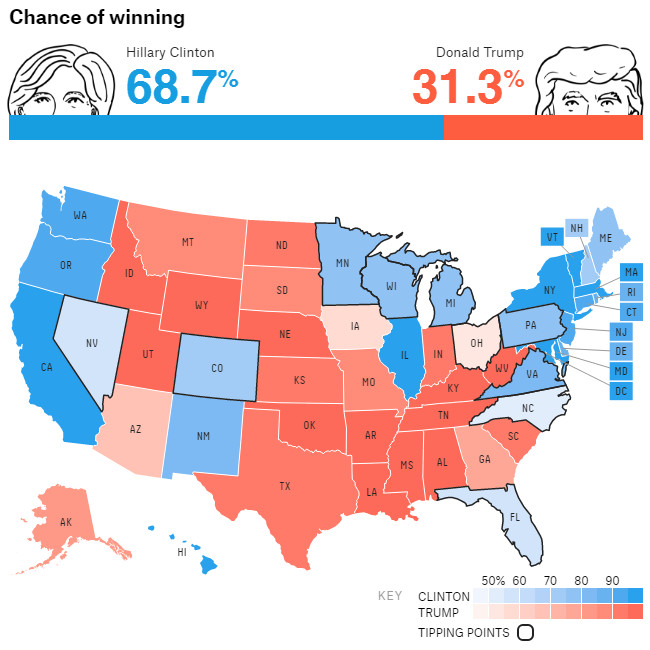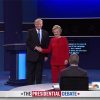
A week after the first presidential debate in the US, and just over a month before the election on November 8th, the polls remain tight, if at times inconsistent. The first debate seems to have led to an improvement in the polls for Hillary Clinton, both with respect to the popular vote and electoral college.
But not by much. While Clinton once led (Aug. 9) by 7.6 percentage points (pp) in a four-way race, her lead had fallen to only 0.7pp by mid-September, according to Real Clear Politic’s average of the polls. However, her numbers began to rise again all through the week prior to the debate, reaching 1.6pp on September 26. Clinton’s lead continued to widen, and four days after the debate it was at 2.9pp (before moderating to 2.3pp today).
This pattern seems to confirm the analysis of those who had pointed out that the presidential debates rarely affect the polls by more than a percentage point or two, and usually in favor of the candidate who had already begun to rise in the polls sometime before the first debate. The movement in the candidates’ relative favorability/unfavorability ratings reflects the same trend of relative improvement for Clinton vs. Trump well before the first debate, after which the relative lead continues to trend mildly in favor of Clinton.
The markets and their proxies have also been moving in the same direction –in favor of Clinton– although these indicators do seem to have been affected by the debate. The live betting odds tracked by RCP had peaked for Clinton at 80% in August, but bottomed out at 65% on the day of the first debate, but then jumped up to 70% within a couple of hours. Over the last week they have further risen to 75%. Other forecasters, like Nate Silver at FiveThirtyEight, give Clinton slightly less odds (66.7% as of today), but his model’s calculations of Clinton’s probabilities have evolved in a similar way (falling from an August peak to a low on the day of the debate followed by a sustained rebound).
This pattern –at odds with the average of the polls tracking the national popular vote (which began to rise during the week before the debate)– suggests that for the markets, at least, the debate did make a clear difference. In any event, the markets do not welcome a Donald Trump victory, and they are sending out signals that a Trump victory would not bode well for the economy and could even provoke a recession.
The debate also seems to have made a difference at the state level and in the layout of the Electoral College map (according to RCP). On August 17, Clinton held a clear lead of 118 votes in the Electoral College. However, most of this lead had evaporated as Trump became competitive in a broad array of potential swing states, and it was only 23 votes by the day of the debate. But in the week since the debate Clinton’s lead has rebounded to 36 votes.
Nevertheless, Clinton’s current lead in the Electoral College, as projected by RCP (201 to 165, with 172 votes up for grabs in 14 ‘toss up’ states) is very precarious. If election goes exactly the way of the current RCP ‘no toss ups’ map (which allocates each state to the leader in the average of the state polls, no matter how slim that margin), then Clinton now leading 292 to 246, would win the election. But with only one exception to that current map –ie, if Trump wins Florida, where Clinton’s lead in the average of the polls is a mere 2pp – then Trump, with the state’s 29 electoral votes, would win the election.
FiveThirtyEight’s electoral college ‘snake’ map is somewhat more favorable to Clinton in its projection: it is still calling Nevada and Colorado for Clinton even though RCP’s electoral map has them in ‘toss up’ status –but with a slight poll average in favor of Trump. Still, the FiveThirtyEight projection still points to the all-important nature of Florida, giving it an 18.7% chance of tipping the election one way or the other in the Electoral College.
Finally, evidence seems to point to a slight drain from Clinton’s still modest lead over Trump in the national popular vote in the direction of Gary Johnson and Jill Stein (when the polls account for the presence of the third-party candidates). On the other hand, there is also reason to believe that the third party effects on the electoral college vote will be more complex, and will depend on how the third party dynamics play out state by state.
It appears that most of that drain away from Clinton is accounted for by the young voters once backing Bernie Sanders. Because the libertarian Johnson draws support from across the spectrum, he could conceivably help Clinton by draining away disillusioned Trump supporters. In that context, a vote defecting from Trump to Johnson is nearly as good for Clinton as one that would defect directly to her.
However, there is at least one scenario (outlined by Nate Silver) in which Johnson would win New Mexico (his home state and where one recent survey gave him 24% of the intended vote), thus stopping either Clinton or Trump from winning the necessary 270 electoral votes. In that case, the election would be decided by the lower house, the House of Representatives where the Republicans are expected to maintain the majority, if with less margin.
Such an outcome would be a strange cousin to that of the 2000 election when the performance of the third candidate, Ralph Nader, tipped the scale against Al Gore in Florida and, given the subsequent ballot controversies in that state, caused the election to be ultimately decided by the Supreme Court, 5 to 4 in favor of George W. Bush.


